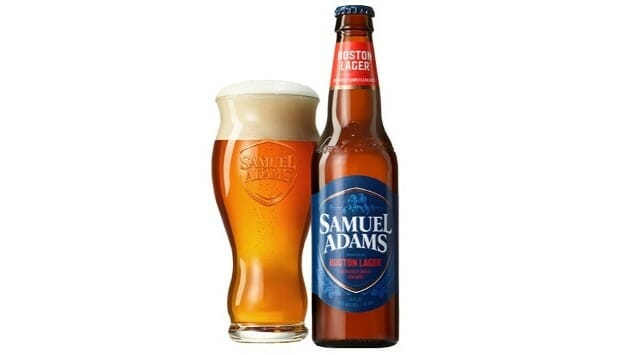My Month of Flagships: Samuel Adams Boston Lager
Photos via Boston Beer Co.
This essay is part of a series this month, coinciding with the concept of Flagship February, wherein we intend to revisit the flagship beers of regional craft breweries, reflect on their influence within the beer scene, and assess how those beers fit into the modern beer world. Click here to see all the other entries in the series.
Observing the modern beer scene, it initially feels odd how a product like Sierra Nevada Pale Ale, and the brewery that makes it, manage to generate almost universal goodwill from the craft beer community as it exists in 2020, but the same can’t always be said about one of the other most important beers in the history of the American microbrewing movement. Because really, even if something like SNPA inspires more devotionals today, or is more trendy for members of Beer Twitter to rep on a Throwback Thursday post, it’s really Samuel Adams Boston Lager that was the single most visible standard-bearer for the idea of “craft beer” in the U.S. for several decades. This was the beer that most people on the street would have been most likely to cite if someone told them to name a “microbrew.” It was the first non-BudMillerCoors lager that many of us sampled as we began to expand our horizons in beer. And yet, today the average beer geek’s relationship with Boston Lager (and Boston Beer Co. by extension) tends to be fraught with a few more shades of gray than how we perceive a company like Sierra Nevada. Somewhere along the way, humble old Boston Lager got surprisingly complicated.
There’s no denying that Boston Lager was a runaway success in the three decades following its debut in 1984, putting the Samuel Adams lineup of beer styles on the map and eventually building Boston Beer Co. into a publicly traded company in a much ballyhooed IPO in the mid-1990s, even as it became the biggest “craft brewer” in the country via the Brewers Association definition of the term. Leaning on the savvy business sense and “everyman beer dude” likability of co-founder Jim Koch as its public face, the brand projected an amiable, non-threatening vibe that was key in converting drinkers who had been pounding industrial macro lager for decades. At the same time, though, Boston Beer Co.’s advertising for Boston Lager also went a long way toward establishing some of the tropes we now associate with seemingly every single depiction of craft beer advertising, such as the “founder with a fistful of hop flowers, inhaling deeply” publicity shot that Koch has surely recreated 1,000 times at this point. Other brands like Anchor or SNPA may have been on the market first, but it was Boston Lager that really felt most perfectly built for mass appeal.
Part of that, of course, comes down to how perfectly the beer itself fit into the emerging interest in more flavorful drinks during craft beer’s adolescent years. Whether intended or not, Boston Lager’s European influences and hint of amber maltiness were exactly the sort of mild deviation from the norm that provided a perfect stepping stone/entry point to generations of drinkers who were sampling “better beer” for the first time. Nothing about Boston Lager is too assertive, brash or challenging, but its subtle sweetness and hints of Noble hop flavor allowed curious drinkers to dip a toe into “that whole microbrew thing” without venturing too far from their comfort zone. By means of direct comparison, Sierra Nevada Pale Ale would have been too big a departure and too much of a hoppy shock to the system for many of these drinkers. They needed a gentle entry point, and that’s exactly what Boston Lager provided.
Of course, there’s also a downside to being viewed as a potential “training wheels” beer—as the rate of new drinkers entering the craft beer market starts to drop, and the existing craft beer drinker becomes more experienced and selective (we are a picky bunch), a beer like Boston Lager runs the risk of becoming viewed as painfully un-hip, and it’s difficult to argue this isn’t exactly what happened in the 2010s. Growth of the brand slowed, then eventually slipped into yearly declines, along with the rest of the Samuel Adams beer lineup. At the same time, Boston Beer Co. threw more of its attention into the more rapidly expanding areas of its business—first hard cider via Angry Orchard, and then shockingly successful malternatives (Twisted Tea) and hard seltzer (Truly). And all in all, it only took a handful of years for the previously unthinkable to happen—production of non-beer products at BBC surpassed the production of beer. This prompted another change of that pesky “craft brewer” definition by the ever-protective Brewers Association in order to keep Boston Beer Co. in the fold, but the truth of the matter is that Boston Lager has never been less important to the future of the company than it is right now. And that’s a little sad, considering how much Boston Lager undoubtedly meant to so many burgeoning craft beer geeks of the 1980s, 1990s and 2000s.
Still: Times change, even if the beer stays the same. Unlike some of the other beers in this series, Boston Lager is still something I tend to revisit fairly often, so I don’t expect to be shocked by anything in re-tasting it. Let’s see how it’s drinking in 2020.